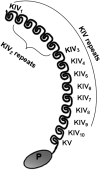Lipoprotein(a) in atherosclerosis: from pathophysiology to clinical relevance and treatment options
- PMID: 32453609
- PMCID: PMC7877976
- DOI: 10.1080/07853890.2020.1775287
Lipoprotein(a) in atherosclerosis: from pathophysiology to clinical relevance and treatment options
Abstract
Lipoprotein(a) (Lp(a)) was discovered more than 50 years ago, and a decade later, it was recognized as a risk factor for coronary artery disease. However, it has gained importance only in the past 10 years, with emergence of drugs that can effectively decrease its levels. Lp(a) is a low-density lipoprotein (LDL) with an added apolipoprotein(a) attached to the apolipoprotein B component via a disulphide bond. Circulating levels of Lp(a) are mainly genetically determined. Lp(a) has many functions, which include proatherosclerotic, prothrombotic and pro-inflammatory roles. Here, we review recent data on the role of Lp(a) in the atherosclerotic process, and treatment options for patients with cardiovascular diseases. Currently 'Proprotein convertase subtilisin/kexin type 9' (PCSK9) inhibitors that act through non-specific reduction of Lp(a) are the only drugs that have shown effectiveness in clinical trials, to provide reductions in cardiovascular morbidity and mortality. The effects of PCSK9 inhibitors are not purely through Lp(a) reduction, but also through LDL cholesterol reduction. Finally, we discuss new drugs on the horizon, and gene-based therapies that affect transcription and translation of apolipoprotein(a) mRNA. Clinical trials in patients with high Lp(a) and low LDL cholesterol might tell us whether Lp(a) lowering per se decreases cardiovascular morbidity and mortality.KEY MESSAGESLipoprotein(a) is an important risk factor in patients with cardiovascular diseases.Lipoprotein(a) has many functions, which include proatherosclerotic, prothrombotic and pro-inflammatory roles.Treatment options to lower lipoprotein(a) levels are currently scarce, but new drugs are on the horizon.
Keywords: Lipoprotein(a); atherosclerosis; pathophysiology; treatment.
Conflict of interest statement
The authors declare that they have no conflicts of interest regarding this review.
Figures


Similar articles
-
Lipoprotein(a) and proprotein convertase subtilisin/kexin type 9 inhibitors.Clin Res Cardiol Suppl. 2019 Apr;14(Suppl 1):45-50. doi: 10.1007/s11789-019-00099-z. Clin Res Cardiol Suppl. 2019. PMID: 30838555
-
PCSK9 Inhibition with alirocumab increases the catabolism of lipoprotein(a) particles in statin-treated patients with elevated lipoprotein(a).Metabolism. 2020 Jun;107:154221. doi: 10.1016/j.metabol.2020.154221. Epub 2020 Mar 30. Metabolism. 2020. PMID: 32240727
-
Lipoprotein(a) reductions from PCSK9 inhibition and major adverse cardiovascular events: Pooled analysis of alirocumab phase 3 trials.Atherosclerosis. 2019 Sep;288:194-202. doi: 10.1016/j.atherosclerosis.2019.06.896. Epub 2019 Jun 8. Atherosclerosis. 2019. PMID: 31253441
-
Familial hypercholesterolemia and elevated lipoprotein(a): double heritable risk and new therapeutic opportunities.J Intern Med. 2020 Jan;287(1):2-18. doi: 10.1111/joim.12981. J Intern Med. 2020. PMID: 31858669 Review.
-
Can Lp(a) Lowering Against Background Statin Therapy Really Reduce Cardiovascular Risk?Curr Atheroscler Rep. 2019 Mar 7;21(4):14. doi: 10.1007/s11883-019-0773-y. Curr Atheroscler Rep. 2019. PMID: 30847681 Review.
Cited by
-
Associations between lipoprotein(a), oxidized phospholipids, and extracoronary vascular disease.J Lipid Res. 2024 Jul;65(7):100585. doi: 10.1016/j.jlr.2024.100585. Epub 2024 Jun 26. J Lipid Res. 2024. PMID: 38942114 Free PMC article.
-
Cardiovascular Implications of Lipoprotein(a) and its Genetic Variants: A Critical Review From the Middle East.JACC Asia. 2025 Jul;5(7):847-864. doi: 10.1016/j.jacasi.2025.04.012. JACC Asia. 2025. PMID: 40610121 Free PMC article. Review.
-
Lipoprotein(a) and its linear association with all-cause and cardiovascular mortality in patients with acute coronary syndrome.Front Endocrinol (Lausanne). 2025 May 27;16:1580298. doi: 10.3389/fendo.2025.1580298. eCollection 2025. Front Endocrinol (Lausanne). 2025. PMID: 40496568 Free PMC article.
-
Unusual Evolution of Carotid Atherosclerosis in a Patient with Transient Ischemic Attack.Life (Basel). 2025 May 22;15(6):831. doi: 10.3390/life15060831. Life (Basel). 2025. PMID: 40566485 Free PMC article.
-
Role of inflammation and evidence for the use of colchicine in patients with acute coronary syndrome.Front Cardiovasc Med. 2024 Jun 27;11:1356023. doi: 10.3389/fcvm.2024.1356023. eCollection 2024. Front Cardiovasc Med. 2024. PMID: 38993522 Free PMC article. Review.
References
-
- Berg K. A new serum type system in man-the Lp system. Acta Pathol Microbiol Scand. 1963;59:369–382. - PubMed
-
- Rawther T, Tabet F. Biology, pathophysiology and current therapies that affect lipoprotein (a) levels. J Mol Cell Cardiol. 2019;131:1–11. - PubMed
-
- Julius U, Tselmin S, Schatz U, et al. . Lipoprotein(a) and proprotein convertase subtilisin/kexin type 9 inhibitors. Clin Res Cardiol Suppl. 2019;14(Suppl 1):45–50. - PubMed
-
- Dangas G, Mehran R, Harpel PC, et al. . Lipoprotein(a) and inflammation in human coronary atheroma: association with the severity of clinical presentation. J Am Coll Cardiol. 1998;32(7):2035–2042. - PubMed
Publication types
MeSH terms
Substances
LinkOut - more resources
Full Text Sources
Medical
Miscellaneous
